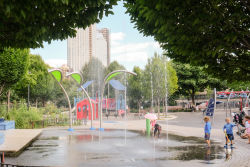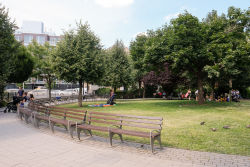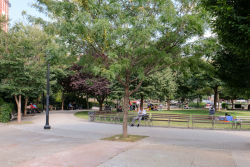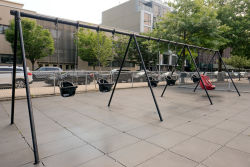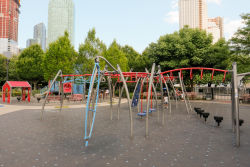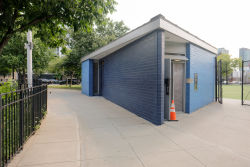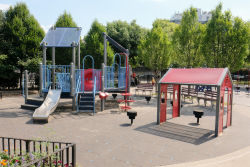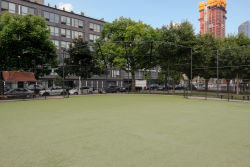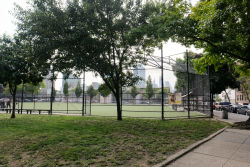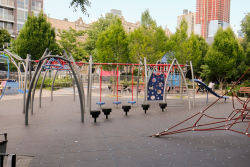Murray Playground
Murray Playground
What was here before?
This site was once home to the Mespeatch peoples, whose name means "at the bad water place" or "overflow," most likely referring to the areas surrounding swamp lands and stagnant water. The Canapaukah Creek, now known as the Dutch Kills, a tributary of Newtown Creek (Mespeatches Kill), flowed up to modern-day Queens Plaza.
In 1643, Burger Jorissen received a patent for land along the Canapaukah, which would have encompassed this site. Jorissen, a well-respected Blacksmith from Silesia, constructed a mill powered by the creek. Though the dam Jorissen built across the body of water was demolished in 1861 due to the construction of the Long Island Railroad, one can still find traces of the mill at the Dutch Kills Green, where two gristmill stones reside. The twin stones were originally preserved by a descendant of the Payntar-Skillman family, who acquired the mill and much of the land in the area in 1801.
Urbanization began in the 1830s when small residential developments started to spring up in the area. By 1910, most of Dutch Kills had been filled with excavated soil from nearby subway construction. The area quickly became a center for transportation and industry. Standard Oil Company occupied much of the 11th Street basin one block away, and an iron works and machine shop were just to the west of the playground across 11th Street.
How did this site become a playground?
The City of New York acquired the land for Murray Playground in four parts by purchase and condemnation between 1941 and 1945. In 1978 the Housing and Community Development Act and the Heritage, Conservation, and Recreation Services funded renovations within the park which included the addition of new basketball, handball, and shuffleboard courts, as well as a baseball field, play equipment, and sitting areas. New safety surfacing was installed in 1996, and between 2010 and 2014, several portions of the park were upgraded. Improvements included replacing the paved area with greenery and adding a new public restroom, a synthetic turf field, a dog run, new play equipment, and a performance area with a stage and tiered seating wall.
Who is this playground named for?
Murray Playground is one of a handful of parks named for former Parks Department employees. In 1948, a local law renamed the park after John F. Murray (1889-1944), a lifetime Queens resident and a dedicated recreation supervisor for Queens parks for many years.
Murray supervised the Long Island City Knights of Columbus, the local chapter of the Roman Catholic fraternal order which organized charitable events and promoted Catholic causes. Murray was involved with the Elmhurst Elks, another neighborhood fraternal society, where he supervised recreational activities. Murray also organized local boxing tournaments and trained prize fighters such as Paul Berlenbach (1901-1985), the world champion light heavyweight boxer.
On April 10, 1949, Queens Borough President James Burke hosted the dedication and opening ceremony. He described Murray, who had died on April 6, 1944, at the age of fifty-four, as "an outstanding proponent of the proper kind of facilities for the use of the borough."
Check out your park's Vital Signs
Clean & Safe
Green & Resilient
Empowered & Engaged Users
Share your feedback or learn more about how this park is part of a
Vital Park System

Know Before You Go
The dog run at Murray Playground is closed to the public until further notice. Dog owners are encouraged to visit the nearest dog run, located at Gantry Plaza State Park.


